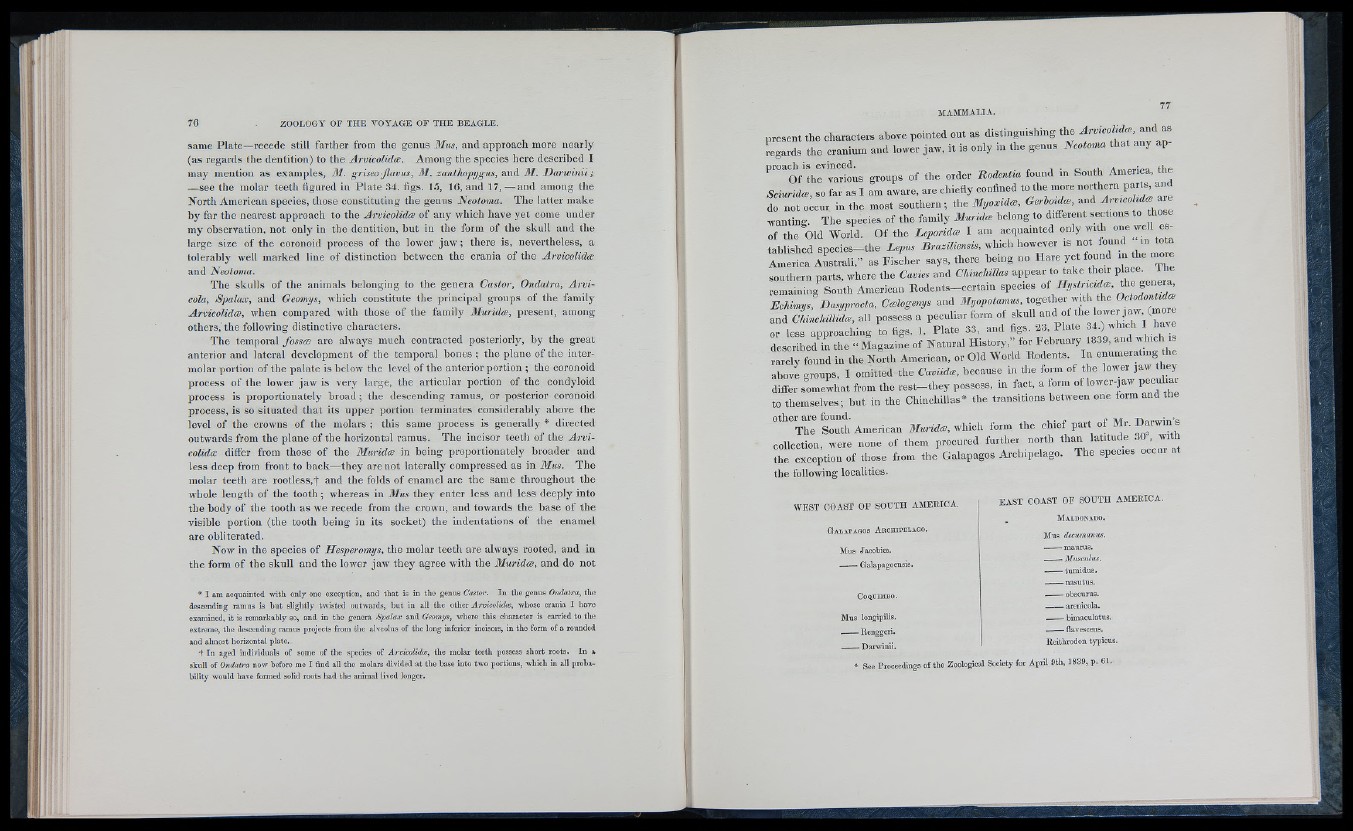
same Plate—recede still farther from the genus 3Ins, and approach more nearly
(as regards the dentition) to the ArvicoUdce. Among the species here described I
may mention as examples, 31. griseoflavits, 31. xanthopygus, and 31. D arwinii;
—see the molar teeth figured in Plate 34. figs. 15, 16, and 17, — and among the
North American species, those constituting the genus Neotoma. The latter make
by far the nearest approach to the Arvicoîidæ of any which have j'et come under
my observation, not only in the dentition, but in the form of the skull and the
large size of the coronoid process of the lower jaw ; there is, nevertheless, a
tolerably well marked line of distinction between the crania of the ArvicoUdce
and Zleotoma.
The skulls of the animals belonging to the genera Castor, Ondatra, A rvicola,
Spalax, and Geomys, which constitute the principal groups of the family
ArvicoUdce, when compared with those of the family 3Iuridce, present, among
others, the following distinctive characters.
The temporal fossæ are always much contracted posteriorly, by the great
anterior and lateral development of the temporal bones ; the plane of the intermolar
portion of the palate is below the level of the anterior portion ; the coronoid
process of the lower jaw is very large, the articular portion of the condyloid
process is proportionately broad ; the descending ramus, or posterior coronoid
process, is so situated that its upper portion terminates considerably above the
level of the crowns of the molars ; this same process is generally * directed
outwards from the plane of the horizontal ramus. The incisor teeth of the Ai'vi-
colidce differ from those of the 3Iuridce in being proportionately broader and
less deep from front to back^—they are not laterally compressed as in 3Ius. The
molar teeth are rootless,t and the folds of enamel are the same throughout the
whole length of the tooth ; whereas in 3Ius they enter less and less deeply into
the body of the tooth as we recede from the crown, and towards the base of the
visible portion (the tooth being in its socket) the indentations of the enamel
are obliterated.
Now in the species of Hesperomys, the molar teeth are always rooted, and in
the form of the skull and the lower jaw they agree with the Muridoe, and do not
* I am acquainted w ith only one exception, and th at is in the genus Castor. In the genus Ondatra, the
descending ramus is but slightly twisted outwards, bu t in all the other Arvicoîidæ, whose crania I have
examined, it is remarkably so, and in the genera Spalax and Geomys, where this character is carried to the
extreme, the descending ramus projects from the alveolus of the long inferior incisors, in the form of a rounded
and almost horizontal plate.
t In aged individuals of some of the species of Arvicoîidæ, the molar teeth possess short roots. In a
skull of Ondatra now before me I find all the molars divided at the base into two portions, which in all probability
would have formed solid roots had the animal lived longer.
present the characters above pointed out as distinguishing tire
¡•égards the cranium and lower jaw, it is only in the genus Neotoma that any approac^
ShCrtnceff ^ groups of the order Rodentia found in South America, the
Sàuridoe, so far as I am aware, are chiefly confined to the more northern parts, and
do not occur in the most southern; the Myoxidoe, Gerhmdoe, and
wanting. The species of the family Muridoe belong to dffierent sections to hose
of the Old World. Of the Leporidoe I am acquainted only with
tahlished sp ecies-the Lepus JSrukitor«, which however is not found m tota
America Australi.” as Fischer says, there being no Hare yet found in the mo
southern parts, where the Caries and Clducm as appear to take their P
remaining South American R odents-certain species of //ysiriaite, tlie genera,
Echimys, Dasyprocta, Coelogenys and dfycpotoi««., together wdh the
and ChincUllidoe, all possess a peculiar form of skull and of °"'® J > ^
or less approaching to figs. 1, Plate 33, and figs. 23, Plate 34.) which I have
described in the “ Magazine of Natural History," for February 1839, and which is
rarely found in the North American, or Old World Rodents. In enumeiatmg
above groups, I omitted the Caviidoe, because in the form of the lower jaw they
differ somewhat from the rest-th ey possess, in fact, a form of lowei-jaw peouliai
to themselves; but in the Chinchillas* the transitions between one form and the
”‘% h T Smith American üfcridiR, which form the chief part of « '• D ™ n ’s
collection, were none of them procured further north than latitude 30 with
the exception of those from the Galapagos Archipelago. The species
the following localities.
W E ST COAST O F SO U TH AM ER ICA .
G a la p a g o s A r c h ip e la g o .
Mus Jacobiæ.
Galapagoensis.
CoquiMBO.
Mus longipilis.
Renggeri.
Darwinii.
EA ST COAST O F SO U TH AM EK IO A .
M a ld o n a d o .
Mus decumanus.
maurus.
M usculm.
tumidus.
nasutus.
I, arenicola.
...------bimaculatus.
-------flavescens.
Reithrodon typicus.
> See Proceedings ot the Zoological Society for April 9th, 1839, p. 61.